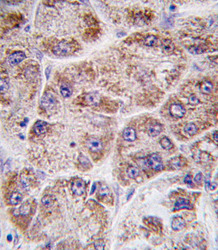Antibody data
- Antibody Data
- Antigen structure
- References [5]
- Comments [0]
- Validations
- Western blot [1]
- Immunohistochemistry [1]
Submit
Validation data
Reference
Comment
Report error
- Product number
- AP2418b - Provider product page

- Provider
- Abcepta
- Proper citation
- Abgent Cat#AP2418b, RRID:AB_2104750
- Product name
- FDPS Antibody (Center)
- Antibody type
- Polyclonal
- Antigen
- Synthetic peptide
- Description
- Purified Rabbit Polyclonal Antibody (Pab)
- Reactivity
- Human
- Host
- Rabbit
- Isotype
- IgG
- Vial size
- 400 µl
- Concentration
- 2 mg/ml
- Storage
- Maintain refrigerated at 2-8°C for up to 6 months. For long term storage store at -20°C in small aliquots to prevent freeze-thaw cycles.
Submitted references Liposome encapsulated zoledronate favours M1-like behaviour in murine macrophages cultured with soluble factors from breast cancer cells.
Altered expression of farnesyl pyrophosphate synthase in prostate cancer: evidence for a role of the mevalonate pathway in disease progression?
Mevalonate pathway intermediates downregulate zoledronic acid-induced isopentenyl pyrophosphate and ATP analog formation in human breast cancer cells.
Sterol-regulatory-element-binding protein 2 and nuclear factor Y control human farnesyl diphosphate synthase expression and affect cell proliferation in hepatoblastoma cells.
Reduced expression of the mevalonate pathway enzyme farnesyl pyrophosphate synthase unveils recognition of tumor cells by Vgamma9Vdelta2 T cells.
Sousa S, Auriola S, Mönkkönen J, Määttä J
BMC cancer 2015 Jan 15;15(1):4
BMC cancer 2015 Jan 15;15(1):4
Altered expression of farnesyl pyrophosphate synthase in prostate cancer: evidence for a role of the mevalonate pathway in disease progression?
Todenhöfer T, Hennenlotter J, Kühs U, Gerber V, Gakis G, Vogel U, Aufderklamm S, Merseburger A, Knapp J, Stenzl A, Schwentner C
World journal of urology 2013 Apr;31(2):345-50
World journal of urology 2013 Apr;31(2):345-50
Mevalonate pathway intermediates downregulate zoledronic acid-induced isopentenyl pyrophosphate and ATP analog formation in human breast cancer cells.
Räikkönen J, Mönkkönen H, Auriola S, Mönkkönen J
Biochemical pharmacology 2010 Mar 1;79(5):777-83
Biochemical pharmacology 2010 Mar 1;79(5):777-83
Sterol-regulatory-element-binding protein 2 and nuclear factor Y control human farnesyl diphosphate synthase expression and affect cell proliferation in hepatoblastoma cells.
Ishimoto K, Tachibana K, Hanano I, Yamasaki D, Nakamura H, Kawai M, Urano Y, Tanaka T, Hamakubo T, Sakai J, Kodama T, Doi T
The Biochemical journal 2010 Jul 15;429(2):347-57
The Biochemical journal 2010 Jul 15;429(2):347-57
Reduced expression of the mevalonate pathway enzyme farnesyl pyrophosphate synthase unveils recognition of tumor cells by Vgamma9Vdelta2 T cells.
Li J, Herold MJ, Kimmel B, Müller I, Rincon-Orozco B, Kunzmann V, Herrmann T
Journal of immunology (Baltimore, Md. : 1950) 2009 Jun 15;182(12):8118-24
Journal of immunology (Baltimore, Md. : 1950) 2009 Jun 15;182(12):8118-24
No comments: Submit comment
Supportive validation
- Submitted by
- Abcepta (provider)
- Main image

- Experimental details
- "The anti-FDPS Pab (Cat. #AP2418b) is used in Western blot to detect FDPS in human cytokeratin liver cell lysate. Data is kindly provided by Dr. Masaru Harada from Stanford University (Palo Alto, CA)."
- Primary Ab dilution
- 1:1000
Supportive validation
- Submitted by
- Abcepta (provider)
- Main image

- Experimental details
- "Formalin-fixed and paraffin-embedded human hepatocarcinoma tissue reacted with FDPS antibody (Center )(Cat.#AP2418b), which was peroxidase-conjugated to the secondary antibody, followed by DAB staining. This data demonstrates the use of this antibody for immunohistochemistry; clinical relevance has not been evaluated."
- Primary Ab dilution
- 1:10~50
 Explore
Explore Validate
Validate Learn
Learn Western blot
Western blot